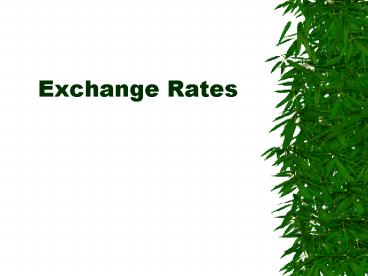Exchange Rates PowerPoint PPT Presentation
1 / 27
Title: Exchange Rates
1
Exchange Rates
2
The Law of One Price
- Prices should equalise across borders, so that
- P EP
- where P is the domestic price of a good, E is the
direct exchange rate (price of foreign currency,
e.g. A1.9/1US), and P is the foreign price of
the good.
3
Purchasing Power Parity (PPP)
- The extension of LOOP to a basket of goods and
services. - E P/P.
- E.g. a reference basket of goods costs C200 in
Canada and US120 in the United States, then PPP
predicts C1.66/US. - PPP says that all countries price levels should
be equal when measured in terms of the same
currency. (Absolute PPP).
4
Absolute Price levels
5
Relative PPP
- Relative PPP states that the percentage
depreciation in the exchange rate between two
currencies over any period equals the difference
between inflation rates in the home country and
in the foreign country - ?E/E ? - ?
6
- Absolute PPP implies that the real exchange rate,
EP/P, should equal 1, while relative PPP implies
that the real exchange rate should be constant.
7
Empirical Evidence on LOOP and PPP
- LOOP does not hold e.g. the Big Mac index shows
wide variability in the price of an identical
good.
8
(No Transcript)
9
- Absolute PPP also does not hold.
- Relative PPP does better, particularly at longer
horizons.
10
(No Transcript)
11
PPP in the short run
- Relative PPP does not explain short run movements
in exchange rates. - The correlation between ?A - ?US and the
depreciation of the A exchange rate against the
US since 1975 is 0.25. - If PPP held exactly this correlation should be 1.
Also the volatility of the exchange rate is
large.
12
(No Transcript)
13
Extensions to PPP
- Why doesnt PPP hold in the short run?
- the exchange rate is an asset price.
- noise traders.
- prices are sticky relative to exchange rates.
- Extensions to PPP.
- PPP assumes that trade is costless and there
are no trade frictions. - high productivity growth countries might expect
an appreciating real exchange rate
14
Exchange Rates and Inflation
- PPP suggests that inflation affects exchange
rates. - In reality there is feedback. Exchange rate
changes pass-through into inflation.
15
Interest Parity
- The interest parity condition for Australian
versus US assets states that - rA rus ?Ee/E,
- PPP implies ?Ee/E ?eA - ?eus
- hence
- rA rus ?eA - ?eus.
16
The J-curve
Balance of trade
time
17
Why a J-curve
- import and export volumes are slow to
adjust after exchange rate changes, - importers may choose not to increase
prices as a result of the exchange rate change
(pricing to market).
18
Practice questions
- Try questions 1,2 and 5.
19
Hedge Funds
- Definition of a hedge fund
- Partnership lt100 members
- Partners are rich!
20
What do Hedge funds do?
- aim to earn high returns, so take risky
positions. Hedge funds derive their name from two
commonly employed strategies - leveraging (borrowing to buy shares or forex)
- short selling (borrowing shares to sell them
and then repurchase later at a cheaper price.)
21
Types of Hedge fund
- macro funds take speculative positions in
financial markets on the basis of financial and
macroeconomic conditions. - arbitrage or relative value funds seek out
arbitrage opportunities among similar assets with
differing prices.
22
Do hedge funds earn superior returns?
- NO!!! (probably/maybe).
23
Do hedge funds create crises?
- No (Mexico, Asian crisis)
- Yes (EMS 1992)
24
Hedge funds attack A
- There were allegations that in early-mid 1998
hedge funds signalled an attack on the A. - The A fell from US0.65 to US0.55 before
recovering. - It does appear that the hedge funds created
considerable volatility.
25
The Hong Kong double play
- Step 1 Buy HK
- Step 2 short sell the Hang Seng Index
- Step 3 Dump HK.
- The assumption was that with HK on a currency
board this would drive interest rates up, and the
HSI down.
26
Why didnt the double play work?
- The HKMA bought HK.
- The HKMA bought stocks.
- Hedge funds lost big at this time.
- LTCM nearly collapsed.
27
How should Hedge funds be regulated?
- do not bail out hedge funds. The LTCM bailout
was a very bad mistake. - improve bank supervision and the supervisory
framework. Improve credit assessment processes
within institutions, change the Basle capital
requirements, etc. These initiatives would reduce
the amount of liquidity available to hedge funds.

